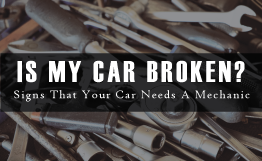Business Hours
- Monday - Friday
- BASHFORD AVE
7:30 AM - 4:30 PM
Phone: (502) 203-0454 - PRESTON HWY
7:00 AM - 4:00 PM
Phone: (502) 230-4279
AMERICAN BRAKE CENTERS INC.
(502) 203-0454 for Bashford Ave or (502) 230-4279 for the Preston Hwy location | 3435 Bashford Ave Ct Louisville, KY 40218
AUTONET TV
Archive for April 2025Catalytic Converter ReplacementPosted April 27, 2025 3:45 AMMany of us have become aware of how important it is to keep our planet’s air clean, and your vehicle has a key component that helps do just that: the catalytic converter. It’s in the exhaust system, and its job is to superheat unburned, harmful byproducts in the exhaust, so they don’t get spewed out into the atmosphere. There’s another important purpose the catalytic converter has: it improves your vehicle’s efficiency. Most of us don’t give the catalytic converter much thought until it breaks or someone steals yours, something that’s been happening much more frequently in recent years. The reason people steal them is that catalytic converters use precious metals such as platinum, palladium, and rhodium to do their job. So, they contain valuable materials thieves can sell. The most likely reason you will have to replace your catalytic converter is age. The more distance your vehicle travels and the more hours your engine runs, it’s putting wear and tear on the converter. T You can tell if your catalytic converter is failing by looking out for these signs:
If you need a new catalytic converter, it can be replaced with an original equipment part if it’s available, or an aftermarket converter can be welded into the exhaust pipe. It’s not uncommon for oxygen sensors to need replacing as well. The technician will also check for other problems in your powertrain that may have contributed to your converter failing. Check to see if an emissions test is required where you live. If it is, you will have to have a properly functioning catalytic converter to pass it. American Brake Centers Inc. Motor Oil?The Synthetic Advantage (Synthetic oil vs Conventional)Posted April 20, 2025 3:46 AMYou’ve probably already heard that regular oil changes are extremely important for the health of your vehicle’s engine. That’s sound advice. But what you might not know is when it comes to motor oil, the real thing may not be the best thing for your engine. There are different types of motor oil: The first thing you need to know is that most new engines require synthetic oil. If synthetic oil is recommended for your car – you MUST use it. For the rest, there are many advantages to using synthetic oil over conventional oil. • Synthetic oil provides better protection for your engine while helping it to perform better. Synthetic oil can be a better choice if you live in an extremely hot or cold climate or put a lot of strain on your engine by towing or carrying heavy loads. It also may be good for older engines that sometimes have a tendency to develop sludge. Synthetic oil is a more expensive option, but you likely won’t have to have your oil changed as often. Some synthetics are recommended to last 10,000-15,000 miles/16,000-24,000 km between changes. You might also consider a synthetic blend that gives you some of the advantages of synthetic oil at a lower cost. Have a talk with your service adviser about recommendations for what will best suit your vehicle and driving habits. It’s interesting to note that in recent years, more than one out of two vehicle owners are opting for synthetic oil or a synthetic blend when they get their oil changed. Sounds like they’re on to something. In the long run, if you have fewer oil changes with synthetics, you’ll use less oil, a bonus for our environment. American Brake Centers Inc. Wired! (Battery Cable Service)Posted April 13, 2025 3:47 AMColder weather brings out the worst in a vehicle's battery. On a very cold day, you may have experienced that your engine cranks slowly when starting. But while it may be the battery itself, it may also be the parts that transfer the power to other the other electrical components, the battery cables. After all, you have to have some way to get the current out of the battery and out to where it needs to go. Battery cables have a couple of enemies: corrosion and age. You may have looked under the hood and noticed a light-colored powder or crust around the terminals. That's what happens when acids corrode the ends of the battery terminals. Corrosion inhibits the connection and may reduce the amount of power getting to the electrical accessories to the point where they are not working correctly, if at all. Here are some symptoms of problems with your battery cables. You might notice a clicking sound when you turn the key, some of your vehicle's electrical parts (like the sound system or the horn) don't work or, in some cases, the vehicle won't start at all. When you take your vehicle to a repair facility, the technician will use instruments to check voltages to see how much current is getting to what location. That includes a starter draw test during which the battery's voltage is checked when the starter is cranked. The technician will also visually inspect the cables and the charging system. To make sure the alternator is putting out the right voltage, the technician will measure that as well. If the problem is found to be the battery cable assembly, the entire set may have to be replaced. Sometimes they can be repaired. During the colder months, it's vital that your vehicle has the proper power going to its electrical components. Having a vehicle that won't start or run smoothly is not something you want to battle with when you're already up against challenging weather. Keep your electrons flowing… and your vehicle moving.
The Byte Stuff (Your Vehicle's Computers)Posted April 6, 2025 3:44 AMNobody has to tell you that computers are a part of so many things in our lives. Smartphones, kitchen appliances, vacuum cleaners, televisions. You name it—it has a computer in it. And your vehicle is no exception. The earliest cars relied on the technology of their time, and there was no such thing as a computer. But now, it's not unusual for a vehicle to have as many as 150 computers in it. They perform a variety of functions. An important one is diagnosing your vehicle's problems. There are various sensors throughout modern vehicles that measure thousands of data points. When something is not working correctly, they send a signal to another computer that stores that information. The data can be read by someone who has a special computer that plugs into a port in your car. It displays certain codes that help technicians track down the culprit. But it's not just the diagnostics that are computerized. Everything from your vehicle's fuel injection to anti-lock brakes is. Convenience features such as power windows, rain-sensing windshield wipers, a wi-fi-hot spot, streaming video and navigation are all sophisticated computers. Then there are the safety features; air bags, traction control, automatic emergency braking and a host of others are all dependent on computers. It is important that those computers work correctly because they interface with many of the other computers on board. To properly diagnose problems with those computers requires training and special equipment. Your service facility has invested considerable resources into both, and they are equipped to properly evaluate and repair and/or replace malfunctioning components. Some lament the days when backyard mechanics could pull out their tools and do their own repairs. Those days are fast disappearing with the computerization of vehicles. But look at the bright side. Your vehicle does so much more, has so many more features and travels far more safely than those past generations drove. And they're bound to get better and more sophisticated down the road. American Brake Centers Inc. | ||
SearchArchiveJune 2019 (18)July 2019 (4) August 2019 (4) September 2019 (5) October 2019 (4) November 2019 (4) December 2019 (5) January 2020 (5) February 2020 (4) March 2020 (5) April 2020 (4) May 2020 (5) June 2020 (4) July 2020 (4) August 2020 (5) September 2020 (4) October 2020 (4) November 2020 (5) December 2020 (4) January 2021 (6) February 2021 (4) March 2021 (4) April 2021 (4) May 2021 (5) June 2021 (4) July 2021 (4) August 2021 (5) September 2021 (4) October 2021 (5) November 2021 (4) December 2021 (4) January 2022 (6) February 2022 (4) March 2022 (4) April 2022 (4) May 2022 (5) June 2022 (4) July 2022 (5) August 2022 (4) September 2022 (4) October 2022 (5) November 2022 (4) December 2022 (4) January 2023 (5) February 2023 (4) March 2023 (4) April 2023 (5) May 2023 (4) June 2023 (4) July 2023 (5) August 2023 (4) September 2023 (4) October 2023 (5) November 2023 (4) December 2023 (5) January 2024 (5) February 2024 (4) March 2024 (5) April 2024 (4) May 2024 (4) June 2024 (5) July 2024 (4) August 2024 (4) September 2024 (5) October 2024 (4) November 2024 (4) December 2024 (5) January 2025 (4) February 2025 (4) March 2025 (5) April 2025 (4) May 2025 (4) June 2025 (5) July 2025 (4) August 2025 (5) September 2025 (4) October 2025 (4) November 2025 (5) December 2025 (1) | CategoriesWhat Customers Should Know (48)Fuel Economy (5)Tires and Wheels (2)Timing Belt (5)Fluids (3)Maintenance (8)Service Intervals (1)Alignment (5)Check Engine Light (4)Steering (5)Exhaust (6)Shocks & Struts (2)Air Conditioning (4)Brakes (11)Older Vehicles (1)Cooling System (5)Battery (4)Water Pump (1)Oil Change (7)Transmission (2)Tires (3)Customer Detective Work (1)Fuel Saving Tip: Slow Down (1)Fuel System (2)Auto Safety (3)Keys to a long lasting vehicle (2)Windshield Wipers (2)Serpentine Belt (1)Alternator (3)Automotive News (2)TPMS (2)Headlamps (3)Service Standards (2)Cabin Air Filter (2)Fuel Pump (1)Safety (2)Winter Prep (1)Drive Train (2)Inspection (3)Engine Air Filter (2)Dashboard (1)Spark Plugs (1)Shocks and Struts (1)Battery Replacement (1)Tire Rotation and Balancing (1)Fuel Filter (1)Trip Inspection (1)Brake Service (1) | |








